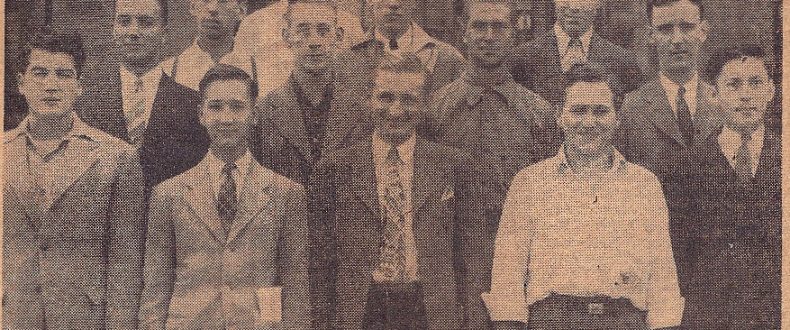The Morning Call: World War II flier story revealed (Lt. Peter Pokrifcsak)
World War II flier story revealed, thanks to researcher
By Bill White, 7:24 p.m. EDT, May 23, 2014 Click here to read the original article and view related documents and photos.
The telegram arrived June 20, 1944.
Catherine Pokrifcsak says she was home from work the day her family got the kind of news that families of American men at war have been receiving for centuries: Your son/husband/brother is dead.
Second Lt. Peter Pokrifcsak of Martins Creek, a flier with the Army Air Corps — and Catherine’s big brother — died on D-Day as his plane returned from a mission to France. But it took his family decades to find out how and why.
That’s where Bill Beigel comes in. He is a California-based American military casualty researcher who has been helping families and other clients get answers since 1998. About 11 years ago, he got a call about Pokrifcsak. Much of what follows is a result of Beigel’s research, which provided far more detail than I have space for here.
Catherine, who lives in Easton — her other surviving sibling, brother Joseph, who fought at the Battle of the Bulge, is in Forks Township — told me Peter was a fine student and a good brother and son.
She concluded, “He couldn’t be any better.”
Peter was buried June 8 at the Brookwood American Military Cemetery in England. His father later decided to have his remains returned home, and Peter was laid to rest in the Church Hill Cemetery, Martins Creek. I visited his grave this week.
From the beginning, his family and friends had hoped for more information about his death. In a letter dated July 2, 1944, Ellen Kroboth, Pokrifcsak’s girlfriend, wrote an Army chaplain on behalf of his family and herself. It said in part:
“The news of Peter, of course, was a very great shock to us all and quite hard to believe especially since he had been over there for only such a short time.
“We’ve received no further information what-so-ever about the accident … We must find out in someway, for it was Peter himself who told both his family and myself, if ever we were to receive news of his being lost, we were not to give up hopes unless we had some very definite information.”
They never got that information, which was classified until 1973. Beigel told me this week, “I think they thought he’d been shot down over Germany or something, which was not what happened.”
Beigel eventually provided a report to his client, Peter’s nephew, Frank Pados of Chatham, N.J. But Beigel came across Pokrifcsak’s name and new information a few months ago when he began working on a series of stories about American fliers downed on D-Day. He wrote a story about Peter on his blog and reached out to some of Peter’s remaining relatives and me.
Beigel told me two events influenced him to do what he does.
As a boy, he saw a famous photo of the crippled B-17 “Wee Willie,” left wing shot away, over Berlin. “I wondered, ‘Who was in that plane? What’s the story?’ ”
He also said the B-17 of his father’s cousin disappeared during the war, and the family remained in the dark. Beigel graduated from UCLA as a history major, and his father later asked him to find out what happened to his cousin.
“He never made it to combat,” Beigel discovered. “His plane was deploying from Newfoundland to Scotland and it went down in a storm, along with a number of other planes.”
Since then, Beigel has done research for many individual and large clients, including a three-year project to document UCLA’s World War II dead. His great website is http://ww2research.com.
Peter Pokrifcsak? Here’s what happened, condensed from the official report filed by the pilot of their B-24 bomber, 1st Lt. Douglas G. McAusland.
“Returning from the enemy coast, I checked the gas gauges from the pilot’s seat as best I could, noting that the supply was low … ” he wrote. “The crew were all at battle stations and the plane still at oxygen altitude until five minutes from English coast.”
When they broke through the clouds at 8,000 feet, one of the engines cut out with no fuel, and he saw the three others were dangerously low. McAusland called each turret to give crew members instructions for either ditching or bailing out.
About three minutes after the first engine died, the others began going out.
“It was evident that we couldn’t reach the airfield at Warmwell, but could possibly bail out over the shore line or very close to it,” he wrote.”At 3000 feet,” he wrote, “I ordered bail out to insure all chutes opening.”
Two officers remained on board with the pilot, who made it barely far enough to crash-land on a short gravel beach. He walked to a Coast Guard station and called his base, reporting that seven enlisted men and one officer — Pokrifcsak — had bailed out over the English Channel. Boats were sent from the beach to pick the men up. The only fatalities were Pokrifcsak, who drowned, and a sergeant who was strangled by his Mae West life jacket and parachute.
Peter’s story is a reminder that Memorial Day isn’t just about honoring people who were cut down in combat or shot out of the sky. Our war dead include men and women who died in training accidents and deadly storms, who were cut down by disease and mechanical failures … and who drowned because their planes ran out of gas. All put their lives at risk on our behalf. For that, we give thanks.
![]() 610-820-6105
610-820-6105
Bill White’s commentary appears Tuesdays, Thursdays and Saturdays.

















